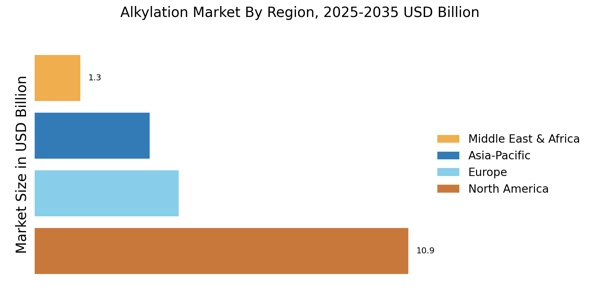Rising Demand for Clean Fuels
The Alkylation Market is experiencing a notable surge in demand for clean fuels, driven by stringent environmental regulations and a global shift towards sustainable energy sources. As countries implement policies to reduce carbon emissions, the need for cleaner-burning fuels has intensified. Alkylation Market processes produce high-octane gasoline components that meet these requirements, making them increasingly attractive to refiners. In 2025, the alkylate production is projected to reach approximately 1.5 million barrels per day, reflecting a compound annual growth rate of around 4.5%. This trend indicates a robust market potential for alkylation technologies, as they align with the broader goals of reducing the carbon footprint of the transportation sector.
Increasing Use of Petrochemicals
The Alkylation Market is witnessing a significant increase in the utilization of petrochemicals, which are essential for various industrial applications. The growing demand for petrochemical derivatives, such as plastics and synthetic fibers, is driving the need for high-quality alkylate products. In 2025, The Alkylation Market is anticipated to reach a valuation of over 600 billion USD, with alkylation processes playing a critical role in producing the necessary feedstocks. This trend suggests that the alkylation market will continue to expand as refiners adapt to meet the rising demand for petrochemical products, thereby reinforcing the importance of alkylation in the broader chemical industry.
Growing Automotive Sector and Fuel Demand
The Alkylation Market is closely linked to the growth of the automotive sector, which continues to drive fuel demand. As vehicle production increases, so does the need for high-octane fuels that enhance engine performance and efficiency. The automotive industry is projected to grow at a rate of 3% annually, leading to an increased consumption of gasoline and, consequently, a higher demand for alkylate. In 2025, the demand for alkylate is expected to rise by approximately 5%, indicating a robust market for alkylation processes. This correlation between automotive growth and fuel demand underscores the vital role of alkylation in meeting the needs of modern transportation.
Regulatory Support for Cleaner Technologies
Regulatory frameworks supporting cleaner technologies are significantly influencing the Alkylation Market. Governments worldwide are increasingly implementing policies that favor the adoption of cleaner refining processes, including alkylation. These regulations often provide incentives for refiners to invest in modern alkylation units that produce low-sulfur fuels. As a result, the market is likely to see a shift towards more environmentally friendly practices, with alkylation processes being at the forefront of this transition. By 2025, it is estimated that around 60% of new refining capacity will incorporate advanced alkylation technologies, reflecting a strong commitment to sustainability and compliance with environmental standards.
Technological Innovations in Refining Processes
Technological advancements within the Alkylation Market are pivotal in enhancing the efficiency and effectiveness of refining processes. Innovations such as improved catalysts and advanced reactor designs are enabling refiners to optimize alkylation reactions, thereby increasing yield and reducing operational costs. The introduction of new technologies is expected to drive the alkylation capacity to approximately 10 million tons by 2026. Furthermore, these innovations are likely to enhance the overall competitiveness of alkylation units, making them a preferred choice for refiners looking to maximize profitability while adhering to environmental standards. As a result, the market is poised for growth, with technology playing a crucial role in shaping its future.


















Leave a Comment